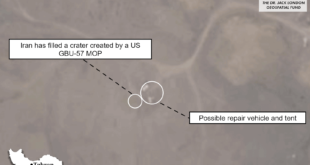A Chinese scientific research ship that set out Monday to explore parts of the South China Sea will flex Beijing’s muscle in a six-way sovereignty dispute without getting other countries riled up enough to chase the vessel away, experts believe.
The Shiyan 6 set off from Guangdong province near Hong Kong toward the northern area of the South China Sea for “multidisciplinary scientific tasks,” the Chinese state-run CGTN news website reported. The Global Times, another Chinese news website, said the ship would “carry out an important scientific mission of multidisciplinary comprehensive observation.”
The Shiyan 6 cost $77.37 million and can travel up to about 22,000 kilometers according to the Beijing-based Baidu online encyclopedia. It was launched in July of last year.
Another Chinese survey ship passed near a Vietnamese energy exploration site in 2019 and again last year to assert Beijing’s claims to those waters. The Shiyan 6 may do the same, analysts say.
“It’s some kind of, like, exercise for those survey ships to be familiar with the South China Sea,” said Nguyen Thanh Trung, director of the Saigon Center for International Studies at the University of Social Sciences and Humanities in Ho Chi Minh City.
“It’s like a theater for those survey ships to do research and to harass the exploration in the region,” he said.
Beijing claims about 90% of the 3.5 million-square-kilometer South China Sea as its own, overlapping waters that five other governments say belongs to them.
Chinese officials point to documents dating back more than 1,000 years to dynastic times as support for their claim. Rival claimants Brunei, Malaysia, the Philippines and Vietnam cite a U.N. maritime convention. Taiwan claims most of the sea as well. Claimants prize the sea for fisheries, fossil fuel reserves and marine shipping lanes.
Jay Batongbacal, international maritime affairs professor at the University of the Philippines in Quezon City, said, “The worst things that they [the Shiyan 6] could do to us is what they did to Vietnam, which is to start surveying and exploring for petroleum.”
The Shiyan 6 may again “harass” Vietnam’s oil project near the Vanguard Bank, a South China Sea feature where Vietnamese contractors have sought oil since 2019, Nguyen said.
The Chinese survey ship Haiyang Dizhi 8 got into a four-month standoff with Hanoi two years ago when it approached oil-rich Vanguard Bank, where Vietnam maintains oil drilling operations.
The standoff ended when the Chinese ship left on its own, its mission apparently complete, but it returned to waters near Vietnam in April 2020 on a separate mission.
Another Chinese survey ship, operated by the Chinese Academy of Science, crossed into the Philippine exclusive economic zone last month, U.S. Naval War College faculty member Ryan Martinson said in a Twitter post in August.
As a nonmilitary vessel, scholars say, the Shiyan 6 will attract relatively little international attention, although foreign governments are likely to track its course. The United States and its allies periodically send naval ships in response to Chinese military movement that they believe threatens international use of the South China Sea.
Western powers, which have taken an increasingly active role in the South China Sea dispute this year, are likely to track the Shiyan 6, but without forcing it to leave, said Derek Grossman, senior analyst with the U.S.-based Rand Corporation research organization.
Rival maritime claimants would avoid it, too, given China’s relative power. Beijing has the third-largest armed forces in the world. It has taken a lead in the maritime dispute over the past decade by building artificial islets for military use. If challenged, Grossman said, China would say the ship is just conducting scientific research.
The survey ship will probably gather information for military and civilian reference, Grossman said. One big project, he suggested, would be mapping the seabed itself. That research would help detect any fossil fuel and prepare for any conflict at sea.
“We actually have very little of the ocean mapped, so that type of information is extremely valuable if you are to do undersea operations in a military conflict,” he said.
 Eurasia Press & News
Eurasia Press & News



